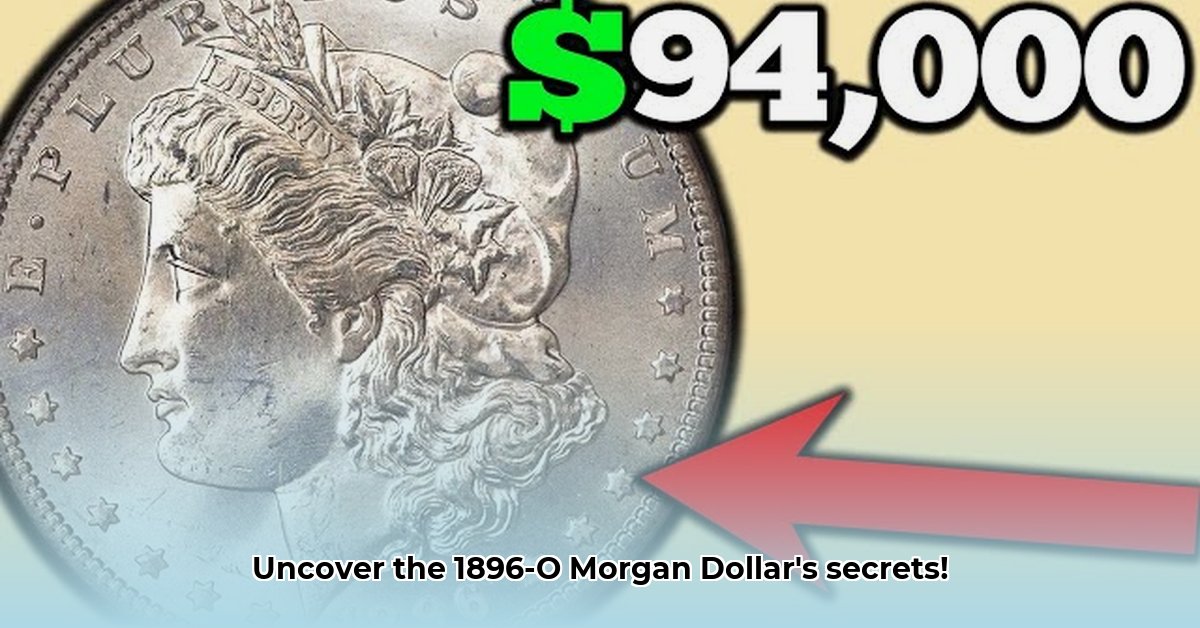
The 1896-O Morgan dollar, minted in New Orleans, presents a compelling case study in numismatic rarity. While its substantial mintage of 4.9 million coins might suggest abundance, the reality is far more nuanced. High-grade examples are surprisingly scarce, creating a dynamic market influenced by factors ranging from minting flaws to the impact of significant coin hoards. This article explores the value, rarity, and authentication challenges surrounding this iconic silver dollar. For more on significant coin discoveries, see this rare coin example.
Understanding the Rarity of the 1896-O Morgan Dollar
The 1896-O Morgan dollar's rarity stems from a confluence of factors. While millions were produced, the survival rate of high-grade specimens is surprisingly low. This scarcity drives market value and collector interest. But how rare is it really?
Poor Striking Quality: Many 1896-O Morgan dollars left the mint with weak strikes and surface imperfections, limiting their potential to achieve high grades like Mint State (MS) or even the nearly-uncirculated Almost Uncirculated (AU). These imperfections significantly reduced the number of "perfect" specimens.
The Pittman Act (1918): This act authorized the melting down of millions of silver dollars to support World War I efforts. This significantly reduced the overall population of surviving Morgan dollars, impacting higher grade examples disproportionately.
The Enigma of Hoards: The discovery of several large hoards of 1896-O Morgan dollars in the mid-20th century injected a significant number of coins, including some high-grade examples, into the market. However, the true extent of previously undiscovered high-grade coins and the long-term impact of these hoards remain subjects of ongoing debate among numismatists. Did these hoards represent a large percentage of the population of high-grade coins, or were they a relatively small fraction of the overall total? The answer is still uncertain.
Value and Market Dynamics
The value of an 1896-O Morgan dollar is directly correlated with its grade and condition. Circulated examples are relatively common and affordable. However, the value increases exponentially as the grade improves, with Mint State (MS) coins commanding significantly higher prices. But how can one tell the difference between an AU-58 and an MS-60? This distinction lies in subtle characteristics that only trained eyes can spot. Consider the following:
Circulated Grades: These are readily available and inexpensive, reflecting their widespread presence.
AU (Almost Uncirculated) Grades: Show minimal wear, but lack the pristine condition of Mint State coins.
MS (Mint State) Grades: These represent the pinnacle of condition, possessing virtually uncirculated surfaces and sharp details. These are the most valuable and sought-after coins.
Market fluctuation is also a significant factor. Current market prices and trends are best identified by consistent monitoring of reputable auction houses and numismatic dealers.
Authentication and Grading Challenges
The popularity of the 1896-O Morgan dollar has unfortunately attracted counterfeiters. Spotting a fake requires keen observation and, ideally, professional authentication. The risk of purchasing counterfeit coins is high, especially for high value, high-grade coins. So, how can collectors protect themselves?
Professional Authentication: This is paramount. Reputable grading services like PCGS (Professional Coin Grading Service) and NGC (Numismatic Guaranty Corporation) provide independent verification of authenticity and grade. Their grading scales provide a common language for collectors and dealers, effectively minimizing the problem of subjectivity when assessing a coin's condition. Professional grading provides important assurance against misrepresentation and adds significant value to a coin.
Visual Examination: Even before professional grading, a thorough visual inspection is crucial. Look for signs of unnatural wear, inconsistencies in toning, and any evidence of cleaning or alteration.
Key Features: Familiarity with the coin's specific characteristics, including die varieties and mint marks, is vital in detecting subtle differences. Variations in the "O" mint mark itself can be significant.
Actionable Intelligence for Collectors
For collectors, navigating the world of 1896-O Morgan dollars requires a strategic approach:
Begin with Research: Thoroughly research the coin's history, market trends, and grading standards. This lays the foundation for informed collecting decisions.
Start Moderately: If relatively new to collecting, begin with lower-grade, circulated examples to gain experience and knowledge before venturing into high-grade, higher-risk investments.
Seek Professional Authentication: Always utilize the services of reputable third-party grading services for assessing high-grade or valuable coins.
Diversify: Avoid investing all resources in a single coin. Build a diverse portfolio to mitigate inherent market risks.
Stay Informed: Keep abreast of market trends and new discoveries (such as newly found hoards) through reputable numismatic publications and online resources.
Understand Provenance: Research the history of ownership of highly graded examples. A well-documented provenance history significantly adds to a coin's value.
The 1896-O Morgan dollar offers a fascinating blend of history, rarity, and investment potential. By understanding the factors that affect its value and employing prudent collecting strategies, enthusiasts can successfully navigate this exciting area of numismatics. Remember, investing in rare coins should only be done after careful research and consideration of all potential risks.